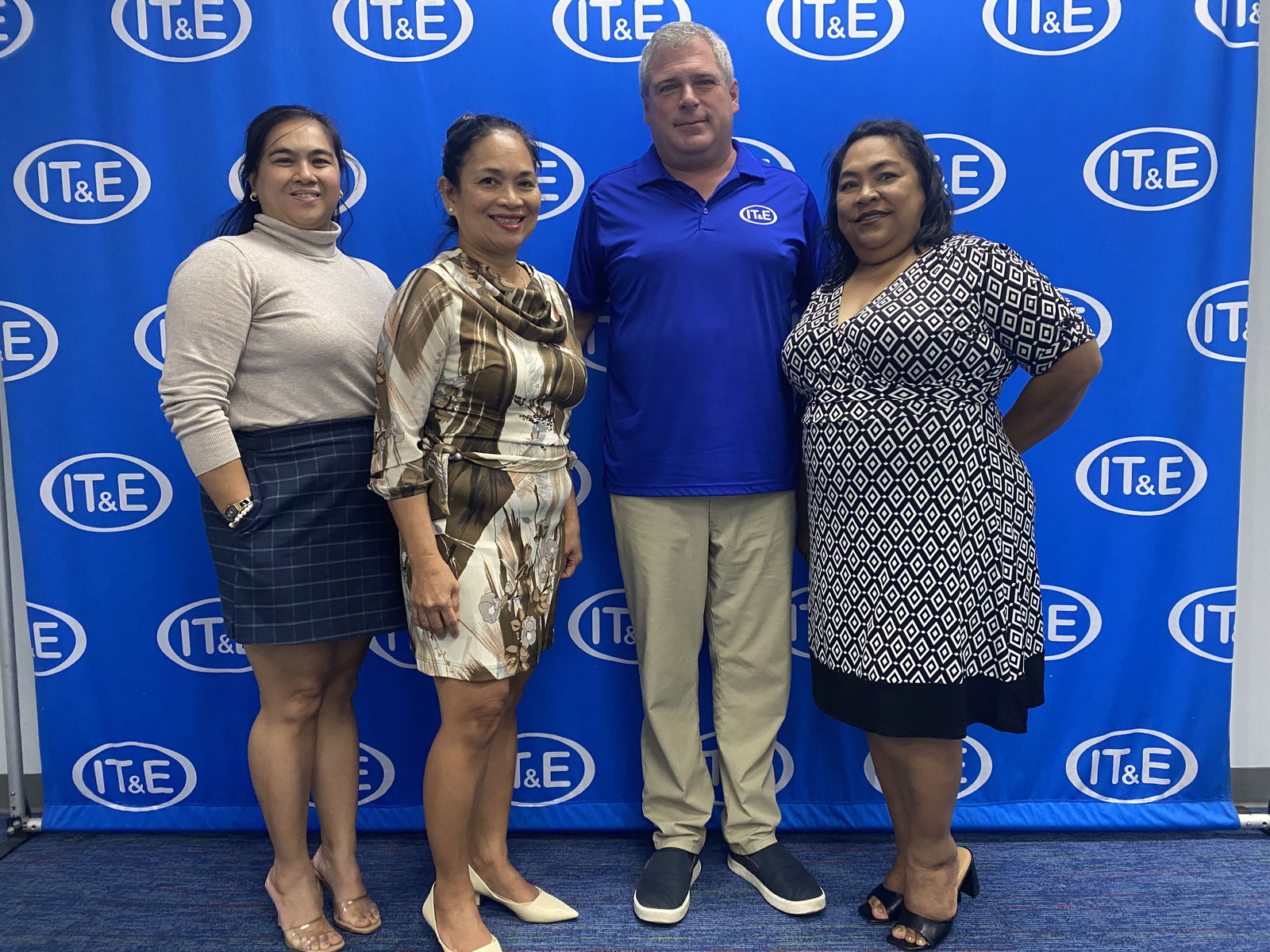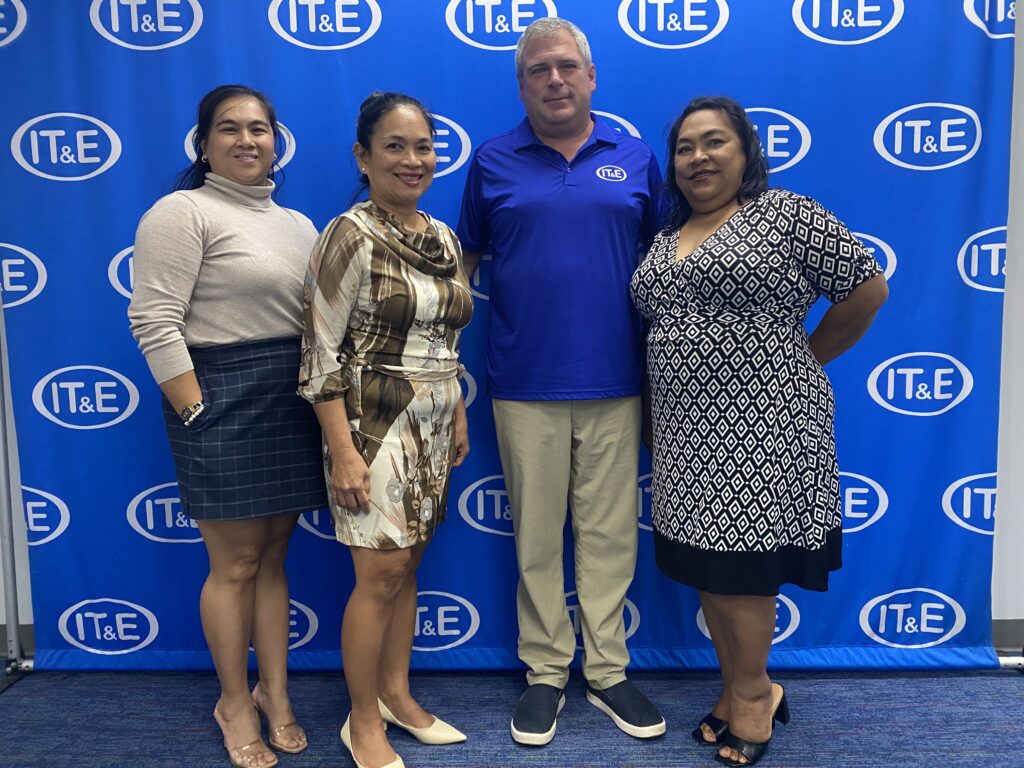
From left, Carisse Vendiola, IT&E chief commercial officer; Velma Palacios, senior director for the CNMI; CEO David Gibson; and Janice Tenorio, senior manager for government relations & customer Service pose for a photo at the IT&E central office in Susupe on Tuesday, Aug. 26, 2025.
IT&E CEO David Gibson spoke to Variety on Aug. 26 to share details of the company’s involvement in the $31 million Broadband Equity, Access, and Deployment fiber optic cable project administered by the CNMI Broadband Policy and Development Office.
Gibson said IT&E is the provisional awardee of the project, which will install fiber optic cable to every home on Saipan, Tinian, and Rota. According to a BEAD fact sheet available on the BPD Facebook page, there are 10,687 locations in the CNMI that could receive the fiber optic cables. IT&E will contribute over $21 million of its own funds to the project, according to the fact sheet.
Gibson confirmed that IT&E already has fiber optic cable along main roadways in the CNMI. For this project, the company will install underground cables along secondary roads. Once those are installed, IT&E will continue installation onto individual properties. He emphasized that fiber cables will be installed even if a home is far from the main road.
“When we say we’re delivering fiber, we’re going to actually go into the street and proactively build fiber right up to each of the homes,” Gibson said.
He added that residents will have the option to opt out of the installation if they do not want fiber optic cable.
“There’s no mandate that residents have to sign up for [fiber optic cable installation]. But obviously, if you’re an IT&E customer and currently on our DSL service, you’ll be migrated onto the fiber. We welcome new customers, but there’s no requirement to take the service,” he said. “If the homeowner doesn’t want us to dig on the property, obviously we won’t do that. We’ll respect the homeowners’ wishes.”
Prior to installation and construction, IT&E will notify residents through digital channels such as email and social media, as well as traditional media. The work will proceed neighborhood by neighborhood, and residents will have a mechanism to opt out of the construction.
Gibson said using buried fiber optics will allow CNMI residents to maintain connectivity during typhoons.
“That was the primary rationale for this particular project. You can expect live connectivity during a typhoon,” he said. “It will be as typhoon-proof as possible.”
He added that the system is a “passive network,” meaning that as long as IT&E and its customers have power, the internet can be delivered into the home. In the event of an island-wide power outage, customers can still access the internet. IT&E’s backup generators safeguard their power supply, and customers who generate their own power, through a generator for example, will still have internet even during the middle of a storm.
The project will affect Zoom meetings, telehealth, video streaming, gaming, and the local economy.
“It’s going to be incredibly fast and reliable,” Gibson said. “Much more reliable than DSL or cable. It will have low latency and be incredibly fast. We see the project as more than just a basic telecommunications project. Looking at the Commonwealth where it is now and where it probably needs to go, we see this as the building blocks for economic development.”
As a provisional awardee, IT&E is awaiting final approval of its contract from the National Telecommunications and Information Administration. Gibson said the Trump administration has given NTIA until the end of 2025 to approve contracts nationwide. Once approved, construction could begin as early as mid-2026, with completion for Saipan, Tinian, and Rota required by 2030.
IT&E’s provisional award has prompted a formal public comment from Docomo Pacific. On Aug. 25 and 27, Docomo released two statements on its Facebook page.
Their Aug. 25 statement noted that a June 2025 NTIA policy notice “fundamentally restructured the BEAD program,” voiding earlier proposals and requiring territories to “reopen their selection processes,” with a focus on cost and technology neutrality.
“The new rules prioritize the lowest total cost per location and remove the prior preference for fiber,” the release stated. “Awarding the entire grant to a single, high-cost fiber project appears to ignore the guidance.”
Docomo added that competition and redundancies are “essential” to ensure internet reliability and affordability.
“Reliance on a single provider puts our community at risk. Outages can knock out ATMs, payroll systems, 911 access, phone, and internet services for days. Giving one company control of all infrastructure threatens jobs, service quality, and disaster preparedness,” the company said.
Docomo clarified that it is not trying to block funding but seeks to “ensure federal funds are used as intended.”
“To those suggesting that our letter aims to obstruct progress: our consistent request has been for a fair, impartial review of all bids under NTIA’s updated guidelines. If the process was conducted properly, there should be no objection to such a review,” the statement added.
Gibson responded for IT&E:
“We’re candidly disappointed that those who didn’t win are trying to set up roadblocks and legal challenges, but we’re confident the CNMI is making the right decision, and the administration is making the right decision.”
The BPD office also released a statement explaining its selection of the provisional awardee. IT&E’s application requested $30 million in funds; GTA Teleguam applied for $60 million; and Docomo bid $90 million.
“We selected and submitted the lowest cost to NTIA for approval, along with our methodology for defining Priority Broadband Projects for each project area,” BPD said. “They said we met their requirements and were satisfied. We moved forward with posting our draft final proposal for public comment as instructed.”
BPD added: “The CNMI Broadband Policy and Development Office has consistently stressed the need for a resilient broadband network for our people — one that isn’t subject to massive outages during our frequent typhoons and storms.”











